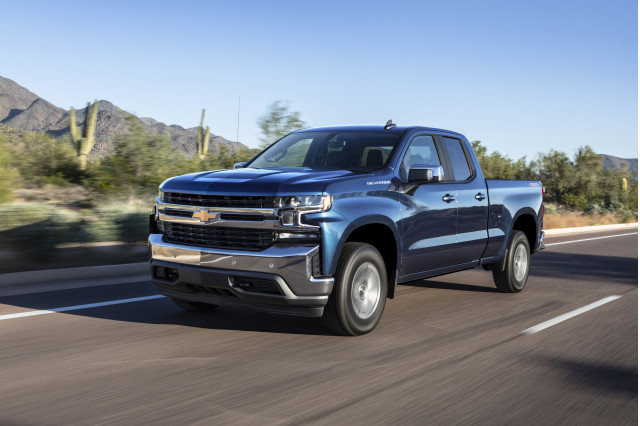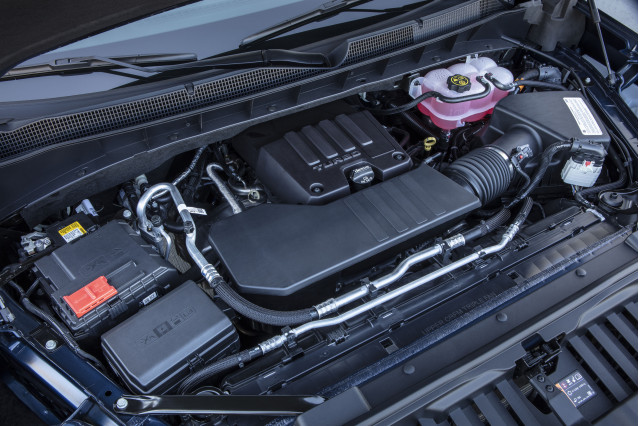
2019 Chevrolet Silverado 1500
Until all cars can become electric, it makes sense to support making internal-combustion passenger cars as fuel-efficient as possible.
It makes even more sense for popular, thirsty large pickups, where each mpg improvement can save a lot more gallons of gas.
Unfortunately, some of the latest attempts as improving fuel economy in big pickups—such as installing small engines with turbochargers to make up for the power difference—don't always bear out in the real world.
The latest illustration came in Car and Driver's test of the new 2019 Chevrolet Silverado pickup with its new everyday engine-choice: a turbocharged, 2.7-liter I-4 rated at 310 horsepower and 348 pound-feet of torque. Those are appropriately big, trucky numbers.
DON'T MISS: 2019 Chevy Silverado will offer new turbo-4 that can run on 2 cylinders
When Car and Driver tested the new Silverado double-cab four-wheel drive with the new 2.7-liter turbo-4, it actually got worse mileage on the highway than an otherwise identical Silverado the magazine had tested with the truck's 5.3-liter V-8 (an updated version of the 5.3-liter in the 2018 Silverado.)
On paper, the small turbo-4 doesn't help the boxy, parachute-like truck on the highway, but benefits it by 3 mpg in the city. The 2019 Silverado with the 2.7-liter turbo-4 gets EPA ratings of 19 mpg city, 22 highway, and 20 combined. With the 5.3-liter V-8, it's rated at 16 mpg city, 22 hwy, and 18 combined.
CHECK OUT: Chrysler to electrify the next Dodge Challenger, boot the V-8?
What the magazine didn't expect was for the highway mileage to be significantly worse with the 4-cylinder. In Car and Driver's highway testing, the V-8 Silverado almost delivered on its EPA highway fuel economy rating at 21 mpg. Choosing the turbo-4, however, actually dropped the mileage by 3 mpg on the highway, to 18 mpg, despite being 314 pounds lighter.
Both trucks use GM's new 8-speed automatic transmission.
The turbocharged I-4 comes standard on the Silverado's two most popular trim lines according to Chevrolet, the LT and the RST. GM says it can run on two cylinders, but given the mileage results, it seems unlikely that the engine did that in the magazine's 75 mph highway test.

2019 Chevrolet Silverado 1500
With the I-4 as the standard engine on the two most popular trims—most likely to boost GM's corporate average fuel-economy ratings—a lot of Silverado buyers may be in for a disappointment when it comes to mileage.
The results are reminiscent of when Ford first introduced smaller turbocharged engines in its F-150 in 2011 and its Fusion sedan in 2013 under the EcoBoost moniker, independent tests showed similar results. The cars showed notable city mileage improvements on their EPA tests, but independent tests actually showed they didn't come close to their mileage ratings on the highway.
Word on the street was that you could "have Eco, or you could have Boost," but not both at the same time.
READ THIS: Engineers find new ways to improve efficiency of gas engines: Engineering Explained
Small turbocharged engines help fuel economy by saving gas when power demand is low and the turbo doesn't have to spin up. In a gas engine, which has to maintain relatively precise air-fuel mixtures, the fuel injection has to add gas to complement the increased airflow from the turbocharger when it's spinning, reducing fuel efficiency when the engine is under load. Car and Driver speculates that at 75 mph in the real world on the highway, the 2.7-liter Silverado is constantly in need of boost.
Page 1 of 2